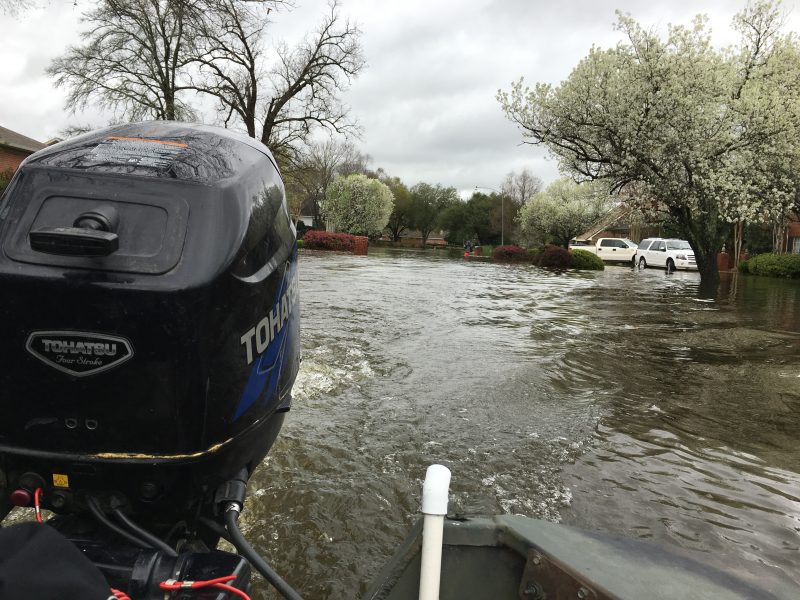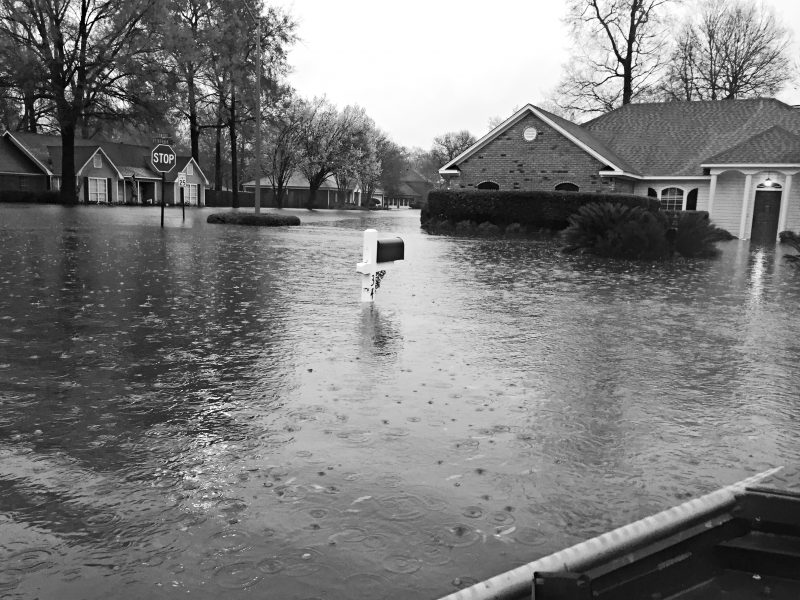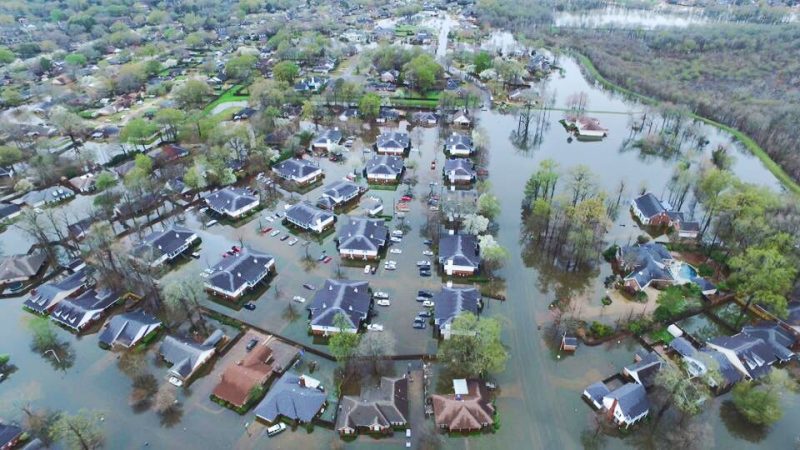 Right now a large portion of South Louisiana sits under water. Just mere months ago, North Louisiana experienced the same trauma, and even though Matthew and I have made it through the hardest parts, the pain/fear/uncertainty/stress still feels fresh. A few weeks into the rebuilding process, I joked that I could now write a manual on “what to do in a flood.” Now, when so many of our friends are suffering through the same things we did, the idea struck that I should actually jot down a few pointers from our experience. Keep in mind, every situation/insurance and mortgage company is different, so these tips are based solely on our experience and could vary based on each individual situation.
Right now a large portion of South Louisiana sits under water. Just mere months ago, North Louisiana experienced the same trauma, and even though Matthew and I have made it through the hardest parts, the pain/fear/uncertainty/stress still feels fresh. A few weeks into the rebuilding process, I joked that I could now write a manual on “what to do in a flood.” Now, when so many of our friends are suffering through the same things we did, the idea struck that I should actually jot down a few pointers from our experience. Keep in mind, every situation/insurance and mortgage company is different, so these tips are based solely on our experience and could vary based on each individual situation.
Here’s what we did:
- Start a “flood notebook.” You are about to be bombarded with information, phone numbers, policy numbers, deadlines, etc. and you’ll want all of that information in one place. My flood notebook was attached to me at all times during the first 3+ months and every bit of information was kept there.
- Contact your insurance company. If you have flood insurance, file a claim immediately. With a disaster of this nature, insurance adjusters will be swamped and you want to get on the books ASAP. If your cars were damaged, you’ll need to file separate claims for those. (Remember to be nice to everyone you speak to. They want to help you.)
- Contact your mortgage company. If you have a mortgage on the property, you’ll need to let the mortgage holder know. They’ll be a part of the rebuilding process and you’ll most likely have to run funds through them to rebuild. Also, they’ll possibly delay your house payments for a few months to help out until you sort things out. (Be mindful that these payments will probably all become due at the end of the delay period. They’re most likely not doing away with those payments – just delaying.)
- Register on disasterassistance.gov. We did not register with FEMA at first because we thought they wouldn’t help since we had flood insurance. That’s not true. Register anyway. There’s most likely things your insurance won’t pay for and FEMA can help with that. If you do not have flood insurance, register right away!! This will most likely be your best form of assistance.
- Take lots and lots of photos. Hundreds. Thousands. You can’t have too many. Take photos in all rooms, from all angles. Inside closets. Inside cabinets and drawers. YOU CANNOT HAVE TOO MANY PHOTOS.
- Find a more permanent place to stay. We were overly ambitious and thought we’d be back home in 3-4 months. We were home before most of our neighbors/friends and it still look way longer than expected. You’re about to be stressed to the max and pushed to limits you’ve never been before. Find a place to retreat. My suggestion would be to plan for something stable for at least 6 months. This way, you’ll be less stressed when you experience delays or bumps in the road.
- Delay/pause your excess utilities. You won’t be using a lot of your excess things like cable, internet, alarm services, etc. for a bit so if you can, pause or cancel those temporarily. Some will be great about this, some won’t. Just save where you can. For internet, for example, it didn’t make sense to cancel so we just dropped it down to the very basic plan. Our alarm company let us disconnect and easily reconnect when we were back home.
- Call your cell service provider. If you begin to run low on data/service, you can call and ask for help. Once the area is declared a natural disaster, some providers will extend your limits for the month so you’re able to make those important calls, etc.
- Write down people to thank in your flood notebook. I kept a running list of those who helped so I could thank them when things settled. (I still have some cards to send.) There is no possible way you’ll remember everyone so start writing down names immediately. And believe me, you’ll want to thank those people. These people will literally be your heroes.
 Once the water is out of the house, here’s some things to do next:
Once the water is out of the house, here’s some things to do next:
- Take more photos. If you took photos while the water was inside the house, take more with the water gone. Be sure to document any visible water lines. Again, be sure to get inside all cabinets and drawers. You want a record of everything in the house.
- Remove any and everything that is salvageable. If it is dry, pack it up and find a place to store it. This is very important – DO NOT PUT ANYTHING EVEN REMOTELY DAMP INTO A BOX WITH DRY ITEMS. If you do, you’ll have lost everything in the box by the time you’re able to unpack it. If you think clothes can be saved, launder them immediately. Remember, it’s not just rain water you’re dealing with here. If it’s dry, get it out immediately and keep it separate from anything wet. If it didn’t get touched by water, insurance probably will not cover it. Save it if you can.
- Pull anything wet out outside. You want to get everything out that’s holding water. Carpet and rugs need to be pulled ASAP. They hold water in the house, so remove them as soon as possible.
- Make note of EVERYTHING, big and small, that’s tossed. As you take something out, write it down. I bought several yellow notepads and some of the girls helping us stood by the doors, making note of everything that was tossed. This will be a LIFESAVER when you go to inventory things for insurance. The more pictures and notes you have, the better. You’ll want to write down the model/serial number of appliances and the other can be general notes…anything that helps trigger your memory of what the item was. It would also help if whoever is writing in that notepad would include their name. That way, if you have questions later, you’ll know who to ask. Also, know how many notepads you have going so you can be sure one doesn’t get misplaced.
- If there’s furniture that you think you can save, clean it immediately, especially before you put it into storage. If it’s upholstered or cloth, it’s probably not salvageable. If it’s cheap furniture or not real wood, you should probably toss it. Anything that’s real wood (antique furniture, etc.) might survive if you clean it and get it dried out immediately. We wiped everything single thing that we thought could be saved vigorously with Lysol/Clorox wipes and let it dry before storing it. Some survived. Some didn’t. Again, be careful storing anything wet because it could ruin everything around it. NOTE: Some real wood items might have faux wood backs, etc. If so, rip those off and try to save the rest. You can add a new back later. Just clean it really, really good.
- If you don’t have a dumpster, make piles within 10 feet of the edge of the road. It’s going to be a while before they can pick these items up, so put them as far out of your way as you can. If you have someone with a trailer or dumpster, these are good options too. If not, make piles close enough to the road that the trash collectors can legally pick it up and far enough back that it won’t fall into the road.
- Begin pulling out sheetrock/insulation. The amount of water you had inside will determine how much sheetrock needs to be removed. Usually, it’s done in 2 or 4 feet increments. It’ll be easier to replace that way. At a minimum, pry away the baseboards. Usually, there’s a gap at the bottom of the sheetrock that’ll allow air to start flowing within the walls. If there’s not a gap or you can’t remove baseboards, knock holes along the bottom of the sheetrock with a hammer. This will allow some airflow. If you’re doing demo yourself, wear gloves. Get gloves for anyone helping you. Pull up flooring, pull out sheetrock, wet cabinets, appliances, etc. Note: It’s ok to do these items before the adjusters come AS LONG AS YOU’VE TAKEN A TON OF PHOTOS. Some people are afraid to start and there’s actually probably a clause in your insurance policy somewhere that says you’ll do everything you can to “maintain the integrity of the home.” In this case, it means getting it dry ASAP. The insurance company will be very unhappy if you simply leave it until the adjuster comes and you’ll only cause more problems that way.
- Hire a professional water remediation specialist. These folks will be swarming your area soon and a lot of them do demo too. We used Clean Master and Service Master is another good one. They’ll professionally dry the home once it’s demoed and treat the studs etc. for mold. You’ll want to hold on to the “dry logs” they provide you because insurance will want them and they’ll be handy when/if you sell the home in the future.
- Accept help. There will most likely be church groups and volunteers everywhere offering help, food, or supplies. This is not the time to be prideful. These people want to help. Let them. You’ll need strength later, I promise. (Just remember to make a note of who helped in your notebook.)
- Choose a good contractor. Your mortgage company will most likely require a licensed contractor to oversee the reconstruction. Pick a good one. The good ones will book up fast, so call as soon as you can. Ask around for suggestions. Listen to reviews. Be sure not to choose a crappy or unreliable contractor.
- Be wary of poachers and scammers. Within hours, you’ll notice people scoping your trash piles and offering services with hand-written business cards. Accept help from others, yet be cautious of people just trying to make a buck from a bad situation. Don’t leave valuables outside, especially not near the trash pile. You might also have investors make offers on your property as-is. This isn’t always a bad deal…just be sure you aren’t taken advantage of. If you have questions about this, contact me.
- Save all receipts. All of them. Anything you buy or pay for right now should be documented. In addition to my flood notebook, I bought an accordion file to keep all paperwork in one spot.
 And a few more practical/sanity related tips:
And a few more practical/sanity related tips:
- If you’re not attached to an item, do not save it. Now is not the time to save anything that doesn’t mean something to you or than you don’t need. Storage will be scarce and once you’re ready to move back in, you won’t want to clutter your new, pretty home with old junk. If it’s damaged or if you don’t love or need it, get rid of it now.
- If there’s an area of the house or items that are important to you, have someone close to you work in that room. My closest friends/family worked in my closet because they knew better how to handle those personal items. They also knew to just toss what was ruined without me seeing it (after writing it on the damaged inventory) because that was easier than me having to face that item at that moment.
- If photos got wet, pull what you can apart gently and lay them out to dry ASAP. They won’t be perfect, but you might can salvage some this way. I also had friends help with this task so maybe I wouldn’t even remember photos that had to be tossed.
- And possibly most importantly, remember that this sucks and it’ll be really, really tough. However, IT’S TEMPORARY. You won’t have to live this way forever and someday things will level back out. I think that the only way I kept my sanity is by constantly reminding myself that I can handle anything for a limited amount of time, and this nightmare is just temporary. As with any situation, it is what you make of it. It sucks and if you let yourself wallow in that, you’ll only make the process worse. It can be positive or negative…you decide your outlook.
- When the new wears off and the volunteers go back to work, you’ll feel the most alone you’ve ever felt in your life. However, there’s a group of us out there that will be constantly thinking about you and cheering you on. I’ll be constantly thinking about you and cheering you on. And I know that you’ll pull through. You’ll come out on the other side with a new perspective on life and you’ll feel invincible. I promise.
These steps are not something I worked on for weeks and I haven’t even proofread. The thought just came to me to share my tips in case it helped just one person find their way in this tough time. I wish I had someone to reply on for instruction when this tragedy first happened to us. If you have questions, feel free to ask. I’m happy to help in any way that I can!
I haven’t shared much yet, but you can find some of our story here or check the #100daysofrebuilding hashtag on Instagram. If you’re struggling today, know that I feel your pain and I’m on this journey with you.
Much love, Pamela
EDIT 8/19/16:
Call the tax assessor. This isn’t something that needs to be done right away. However, make a note to call them when you have time. They’ll keep a tally of damaged homes and this is how they’ll determine whether tax breaks can be given for the year. (Thanks, Madeline, for this reminder.)
*These thoughts and suggestions are all my own. I’m not a professional, nor are these hard and fast rules. This is just my experience and what I did to survive it.
**The last, overhead photo was taken via drone by a neighbor.


Pamela!!!! This is awesome.
Thanks! I hope it helped take the pressure off of someone facing what we faced.
I also saw where you should mark any furniture you put in the trash with a spray painted X so that poachers can’t resale on swap and sale sites.